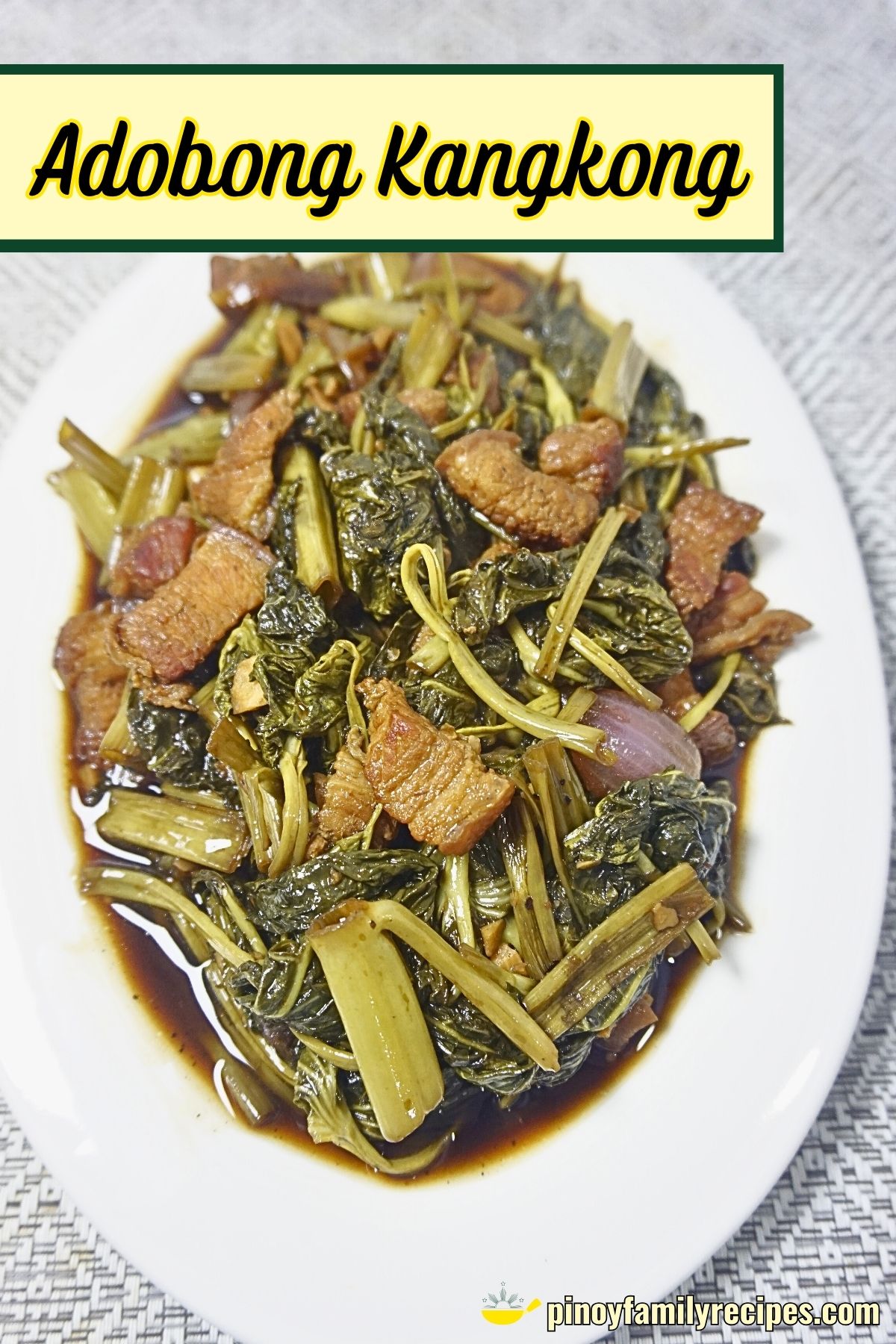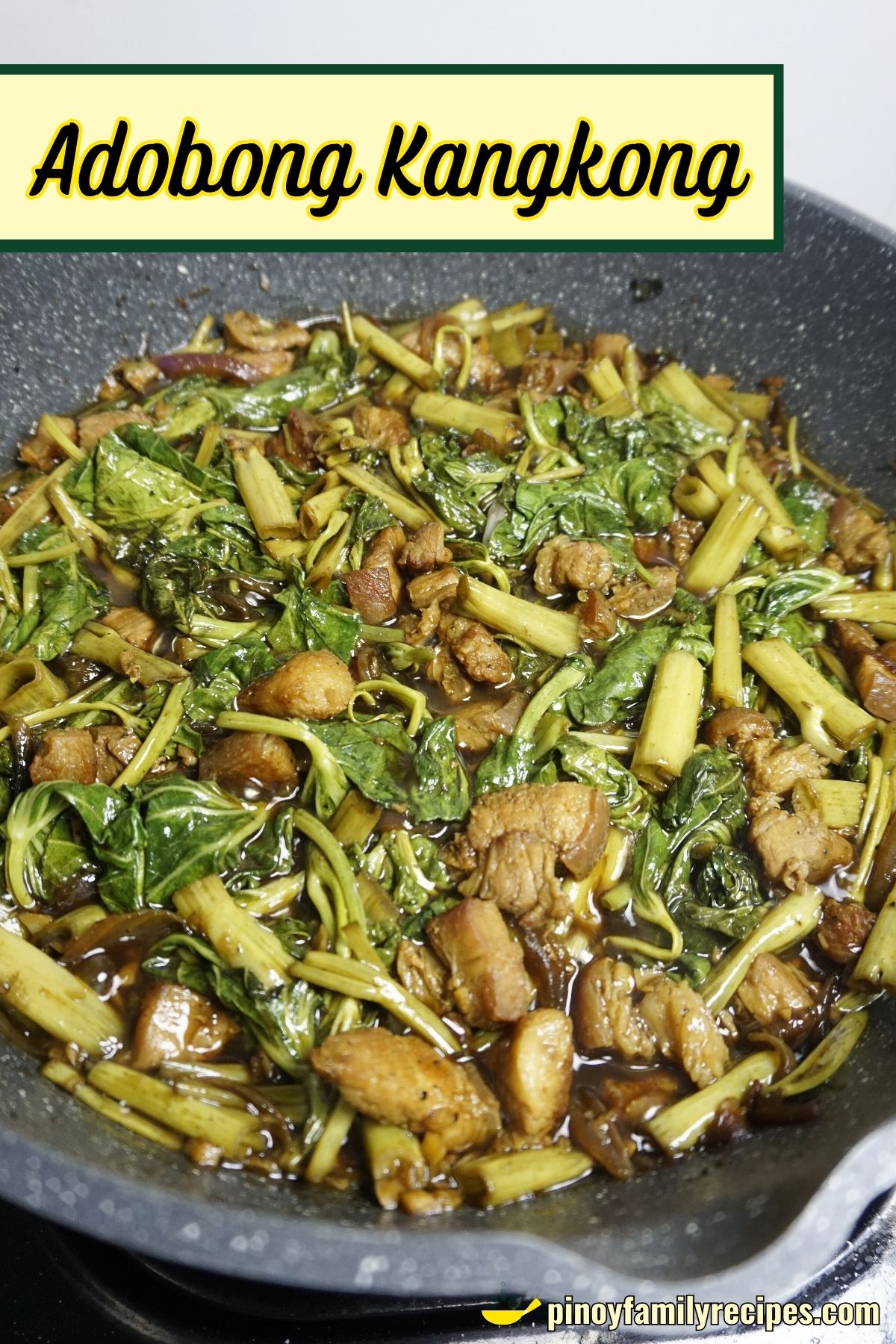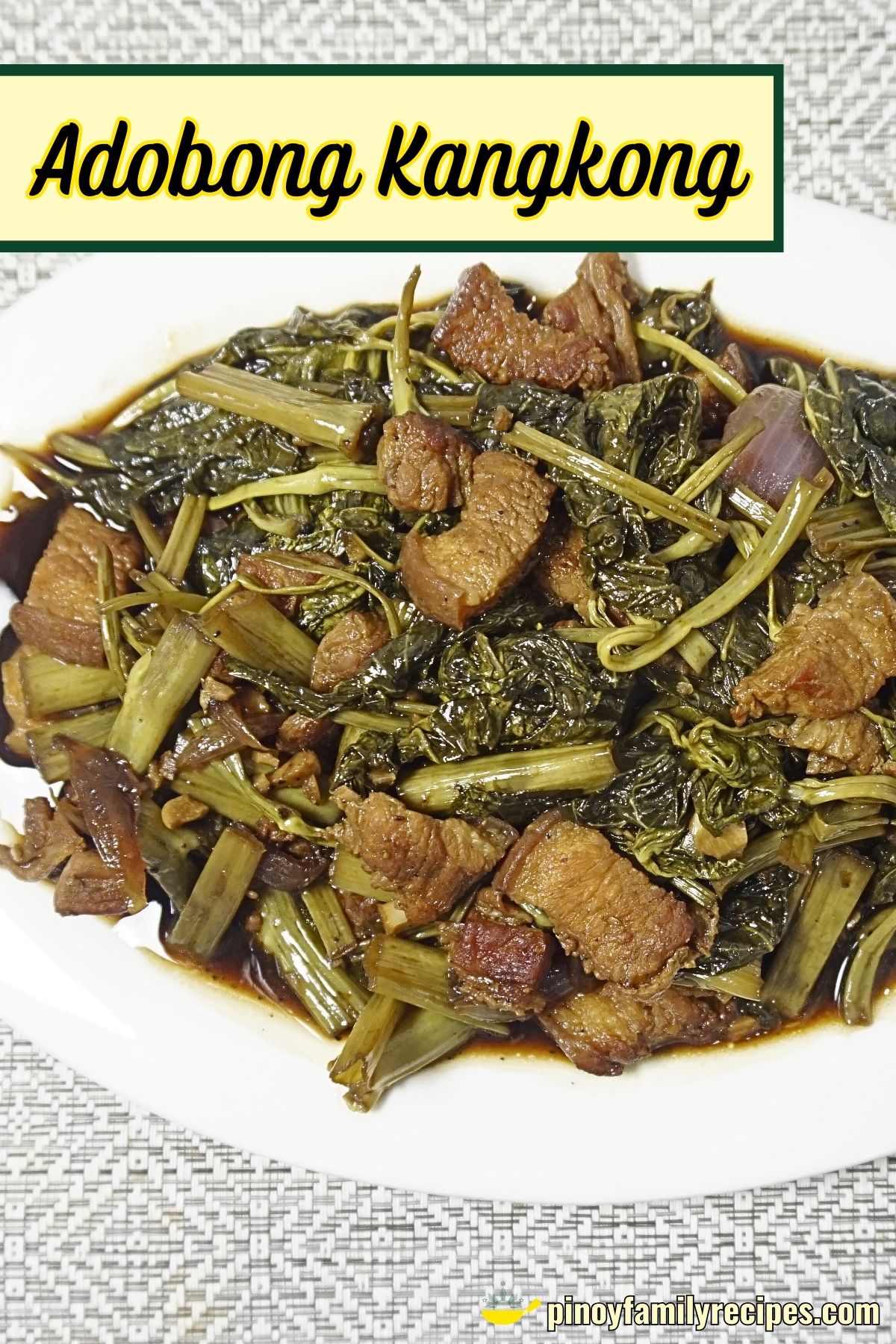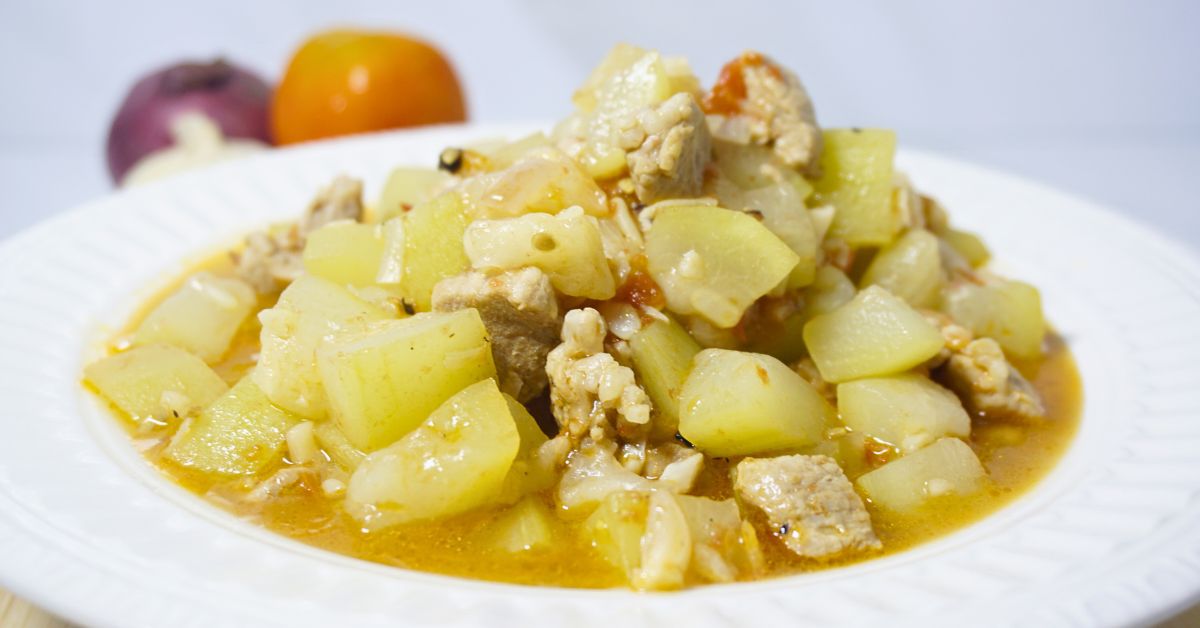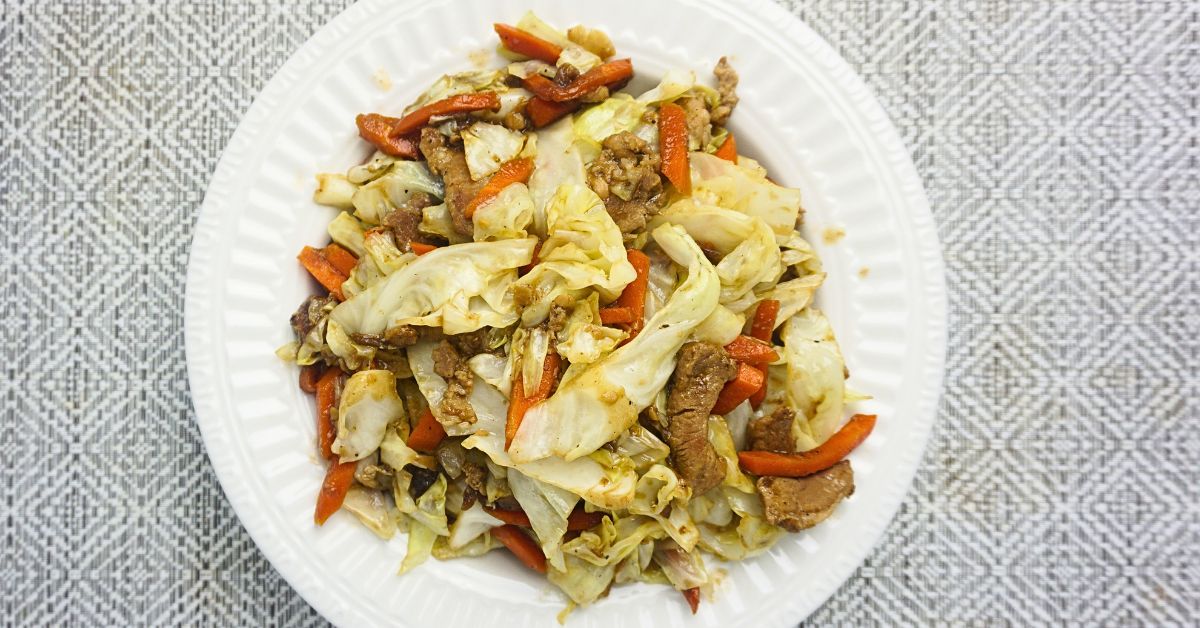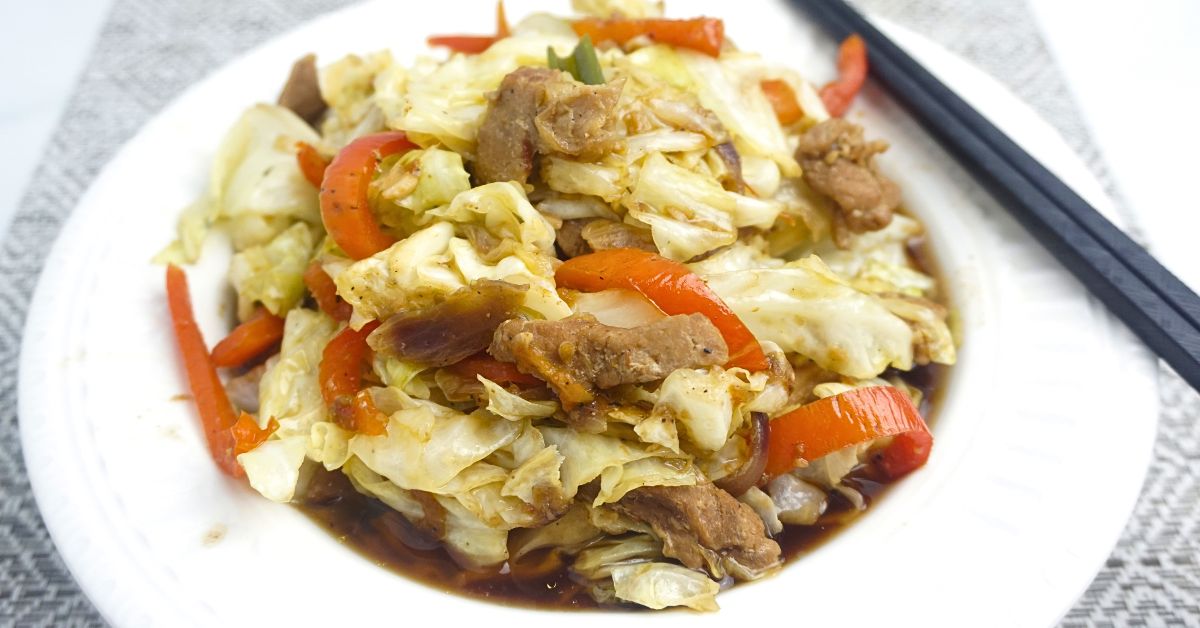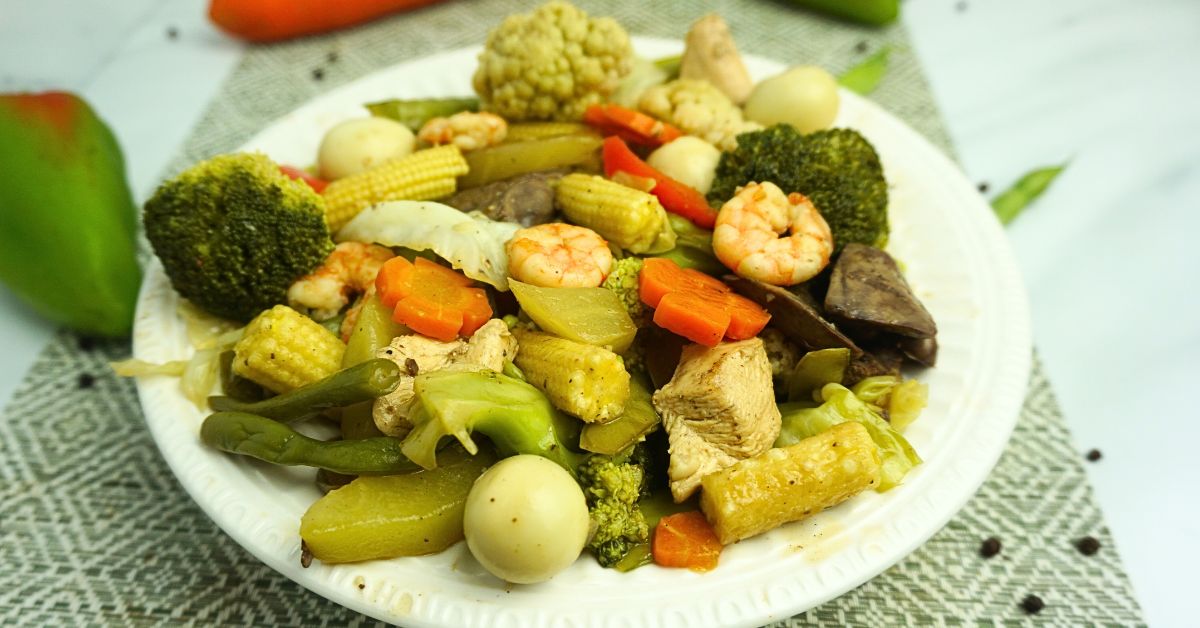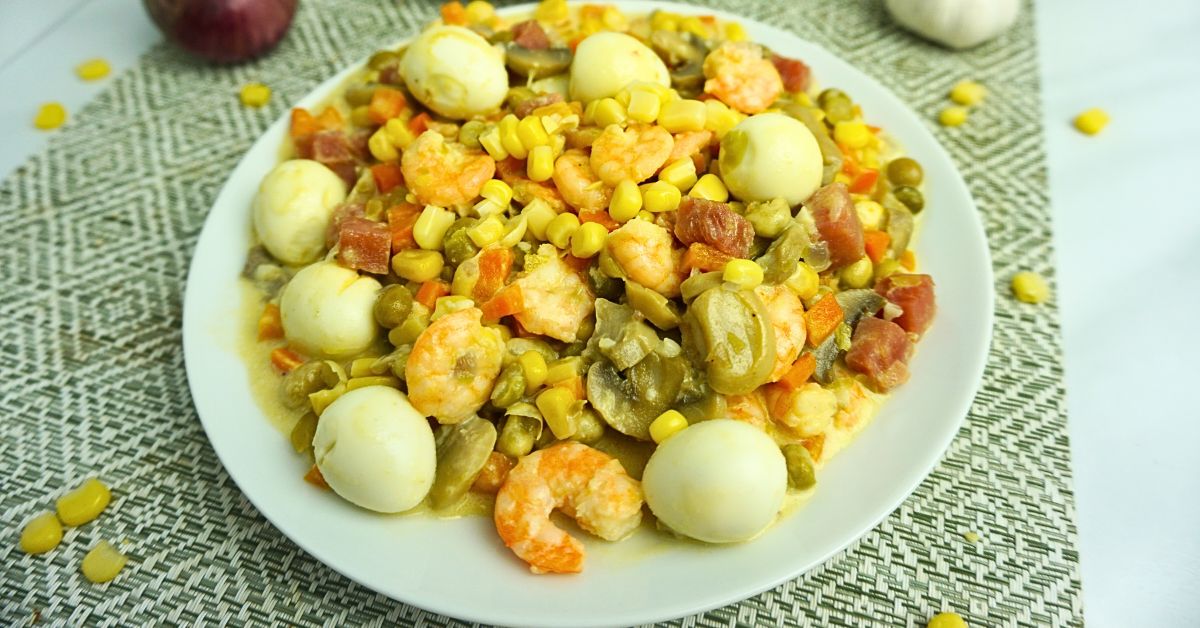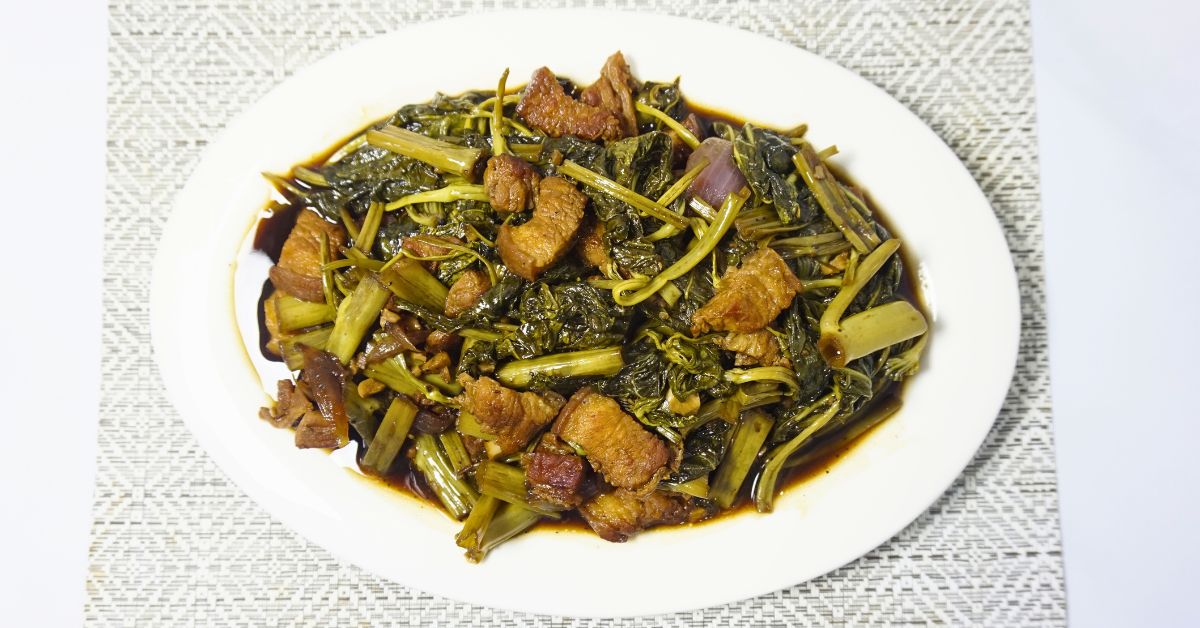
When life gets busy, and the family is hungry, Adobong Kangkong is my quick fix. This simple, flavorful dish is perfect for days when you want something easy but still packed with that delicious adobo flavor we all love.
We’re used to adding kangkong to sinigang, but trust me, it’s just as delicious when you make it adobo style! Imagine tender kangkong soaking up a rich, garlicky sauce that’s a little salty, a little tangy, and absolutely perfect over a mound of rice. It’s got that familiar adobo taste, but with a fresh twist that makes it light and satisfying.
As a dad who loves cooking for my family, I always look for dishes that balance flavor and ease, and Adobong Kangkong is exactly that. It doesn’t take much time or effort, but the taste makes it feel like you spent hours in the kitchen. And if you want to make it a bit heartier, try adding some sahog like pork or tofu – it’ll make the dish even more filling.
So if you’re craving a comforting meal that’s quick to make, budget-friendly, and packed with Filipino flavors, give Adobong Kangkong a try! It’s a simple way to bring big flavors to your table.
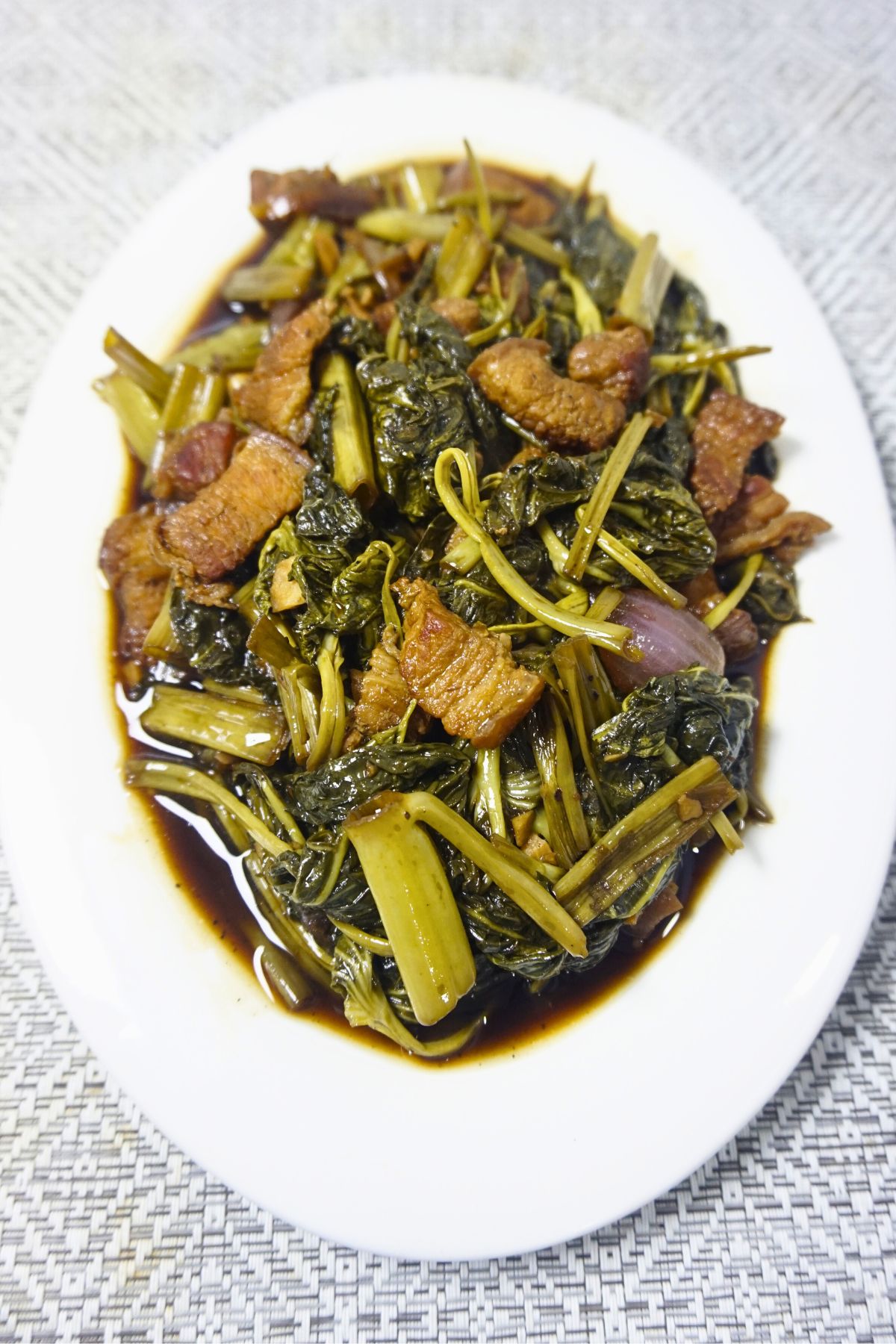
What is Adobong Kangkong?
Adobong Kangkong is a unique version of adobo that puts the spotlight on kangkong, or water spinach, instead of the usual chicken or pork. It’s a popular Filipino vegetable dish where tender kangkong leaves and stems are simmered in a savory sauce made with soy sauce, vinegar, and garlic. This gives it that classic, tangy adobo taste but with a light, fresh twist.
Usually served over rice, Adobong Kangkong is both a budget-friendly and nutritious option that’s super quick to make. It’s a dish that feels homey and comforting, yet it’s light enough to enjoy as a side or main meal. Some add a bit of sahog (like a handful of shrimp or crispy pork bits) to make it more filling, but even on its own, Adobong Kangkong brings out the best of simple, classic Filipino flavors.
Which part of kangkong is edible?
When it comes to kangkong, you can actually eat both the leaves and the tender stems! The leaves are soft and soak up flavor really well, giving you that perfect, savory bite in dishes like Adobong Kangkong. The stems are also edible, especially the younger, thinner parts. They add a bit of crunch, which gives the dish a nice texture.
I usually trim off the tough, woody ends of the stems since those can be a bit hard to chew. But the rest? It all goes in the pan! So when you’re cooking kangkong, feel free to use the leaves and most of the stems for a tasty, full-flavored dish.

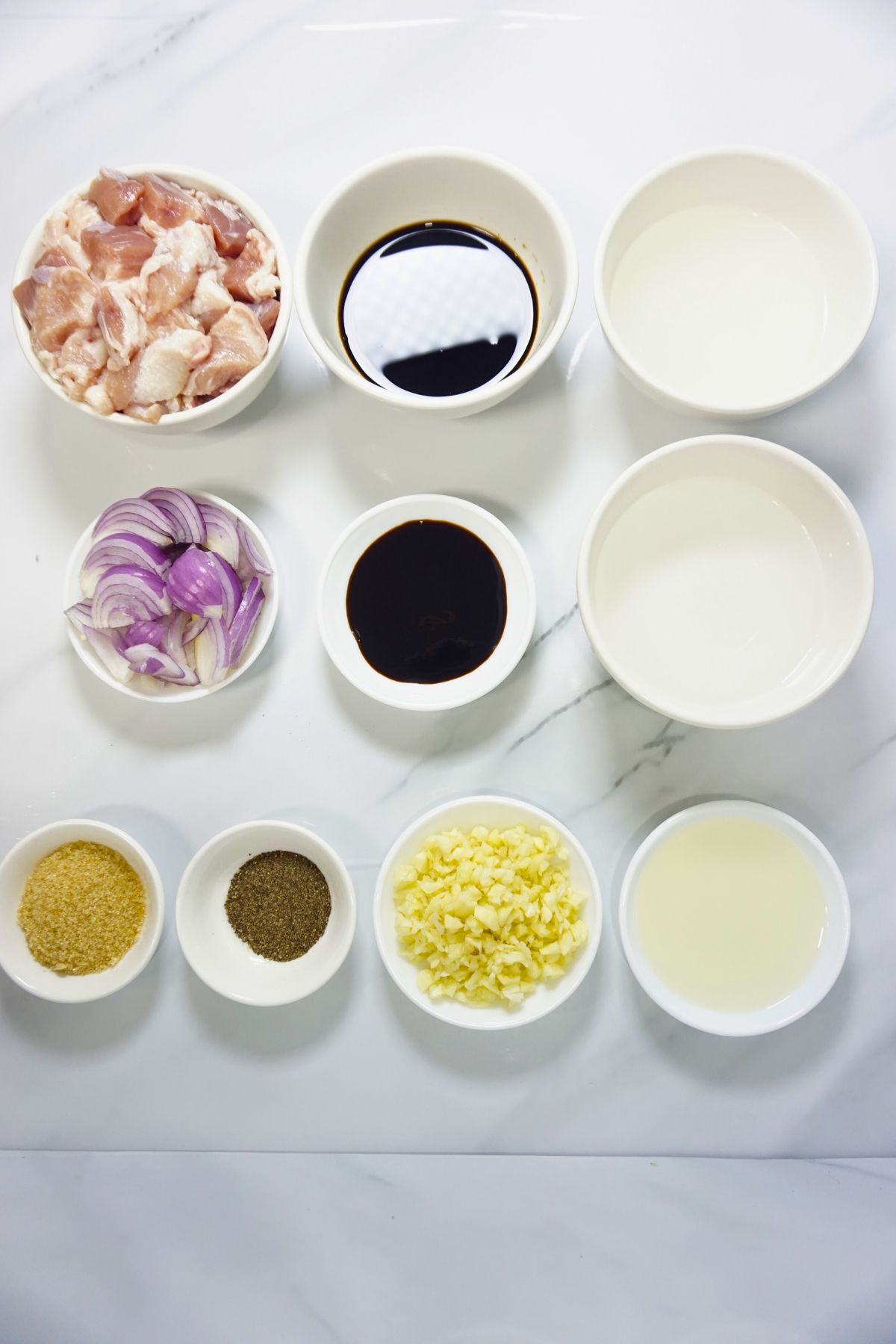
Adobong Kangkong Ingredients
Garlic and Onion – These aromatics add depth to the dish, with garlic bringing a savory aroma and the onion adding a slight sweetness that balances the tangy flavors.
Pork Belly – Sliced into strips, pork belly brings a rich, hearty flavor and a satisfying texture, while its natural fat adds a delicious layer to the sauce.
Soy Sauce and Vinegar – A classic adobo base, the soy sauce provides a salty, umami taste, and the vinegar adds a tangy kick that makes the dish pop.
Oyster Sauce and Brown Sugar – Oyster sauce gives a subtle sweetness and rich flavor, while the brown sugar adds a hint of caramelized sweetness to balance the vinegar.
Black Pepper Powder – This adds a touch of mild heat, enhancing the depth of the savory flavors without overpowering the other ingredients.
Kangkong (Water Spinach) – Both the leaves and tender stems are used, absorbing the sauce’s flavors beautifully while adding a fresh, slightly crunchy texture to the dish.
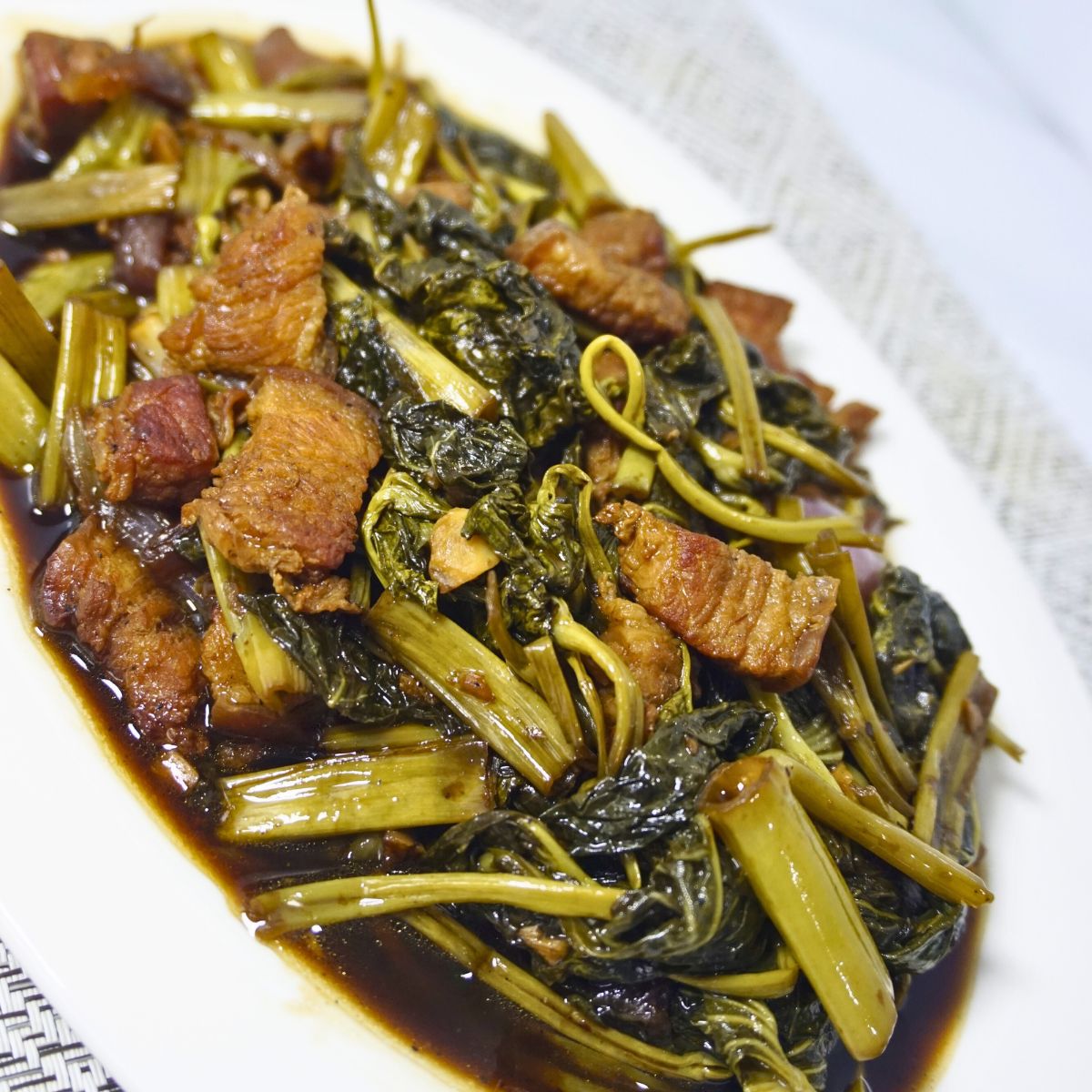
How To Cook Adobong Kangkong?
Prepare Your Ingredients
Start by getting everything ready. Mince the garlic, chop the onion, slice the pork belly into thin strips, and trim the kangkong, keeping the leaves and the tender stalks. This makes the cooking process smoother since everything will be ready to go.
Brown the Pork Belly
In a large pan, heat 2 tablespoons of cooking oil over medium heat. Add the sliced pork belly and let it cook, stirring occasionally. Cook until the pork starts to brown and its fat begins to render, around 5–7 minutes. This step brings out the flavor of the pork, making it nice and rich.
Sauté the Garlic and Onion
Next, add the minced garlic and chopped onion to the pan. Sauté until the garlic is golden brown and the onion becomes soft and translucent. This adds a nice aroma and flavor base for the dish.
Add the Sauces and Vinegar
Pour in the oyster sauce, soy sauce, water, and vinegar. Let it simmer without stirring right away—this helps the vinegar cook off its strong flavor. This mix is what gives the dish that classic adobo taste.
Season the Sauce
Now, add the brown sugar and black pepper powder. Mix everything well so the flavors blend together nicely. The sugar adds a touch of sweetness that balances the saltiness and tang.
Simmer Until Tender
Lower the heat, cover the pan, and let it simmer for about 10–12 minutes. This step makes the pork tender and allows the sauce to thicken slightly, bringing out all the flavors.
Add the Kangkong
Add the kangkong leaves and tender stalks to the pan. Toss them gently to coat in the sauce, and cook for 2–3 minutes until the kangkong is just wilted but still bright and vibrant. This gives the dish that fresh, green touch.
Taste and Adjust
Finally, give the sauce a taste. If it needs a bit more salt or sweetness, you can adjust by adding a little more soy sauce or brown sugar. Serve hot with rice, and enjoy!
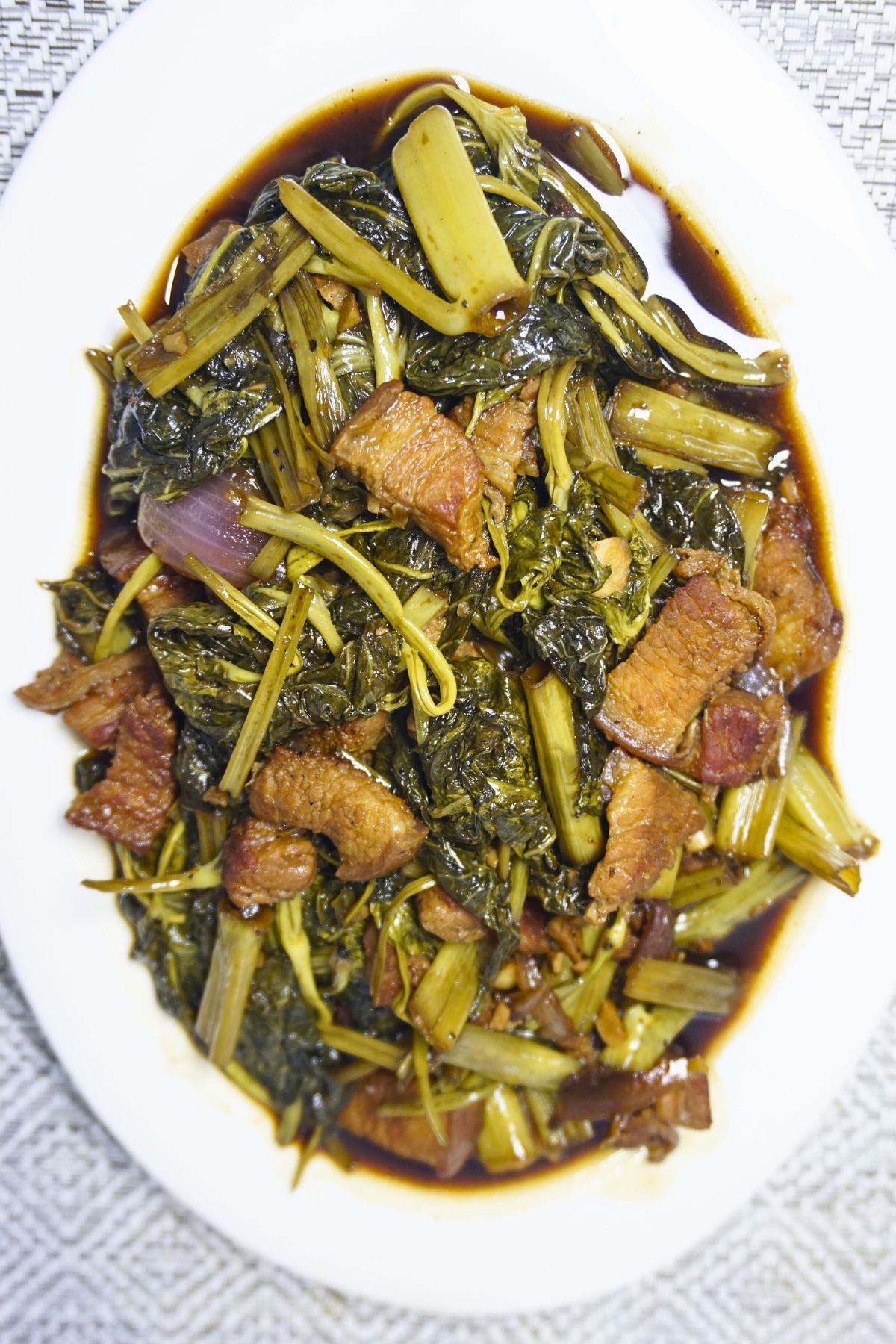
Pro Tips for the Best Adobong Kangkong
1. Brown the Pork for Extra Flavor
If you’re using pork belly, let it brown well before adding the other ingredients. The rendered fat adds richness to the sauce, making it more flavorful.
2. Don’t Stir the Vinegar Right Away
When you pour in the vinegar, resist the urge to stir it immediately. Let it simmer first for a few minutes to cook off its sharpness. This keeps the vinegar tangy but not overpowering.
3. Adjust the Sweetness and Saltiness
Adobong Kangkong is all about balance, so feel free to tweak it to your taste. Add a little more brown sugar for sweetness or soy sauce for saltiness until it’s just right for you.
4. Add the Kangkong Last
Since kangkong wilts quickly, add it just at the end of cooking. This keeps it vibrant and slightly crisp, giving a fresh bite to every spoonful.
5. Experiment with Sahog
For a heartier version, try adding a bit of shrimp, tofu, or even crispy pork bits. These additions make the dish more filling and add another layer of flavor.
6. Serve with Steamed Rice
Adobong Kangkong shines best with a side of steamed rice, which soaks up that tasty sauce. It’s a simple way to make the meal feel complete and super satisfying.
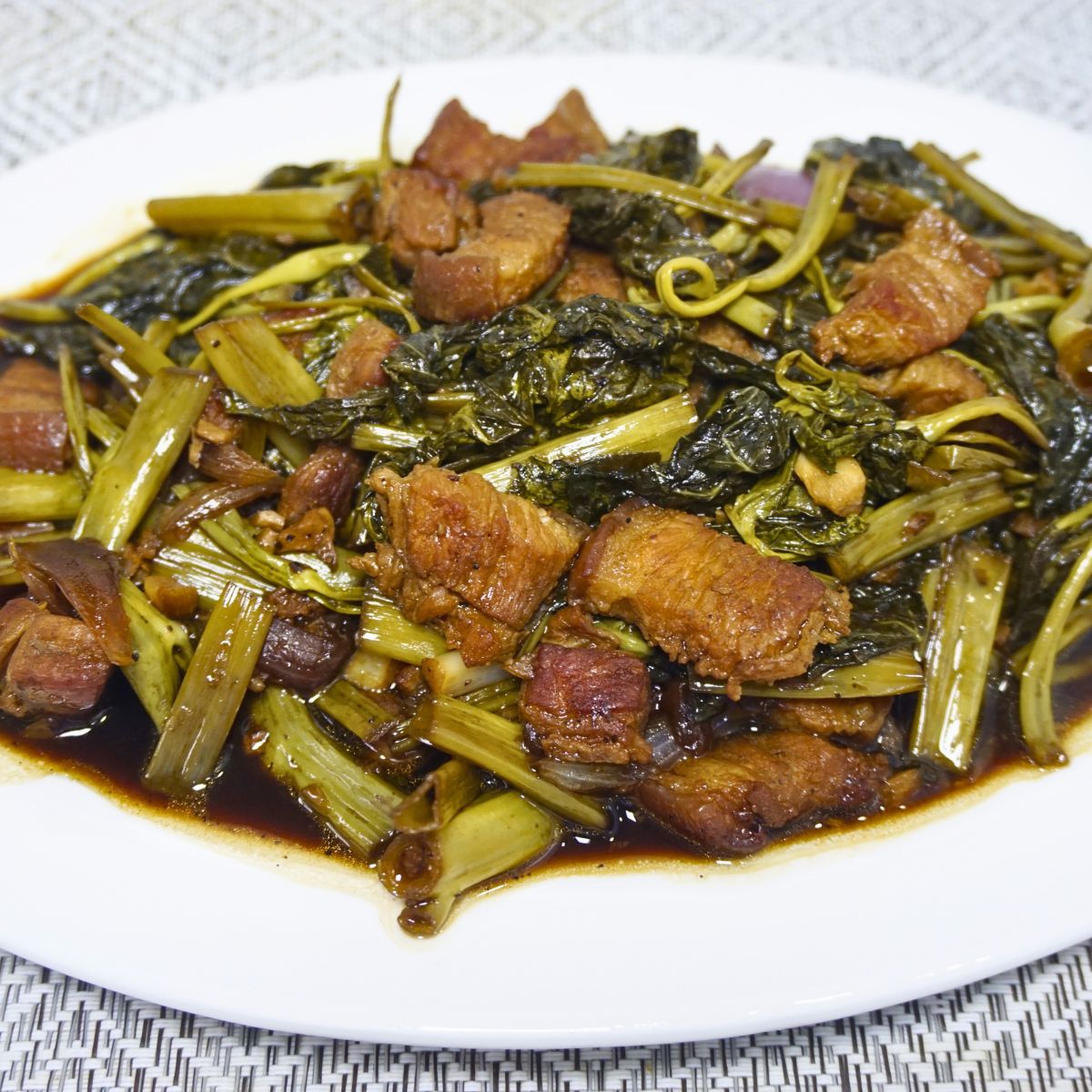
Serving Suggestions
1. Pair with Steamed Rice
The best way to enjoy Adobong Kangkong is with a big serving of freshly steamed rice. The rice soaks up all that delicious, garlicky sauce, making every bite even better.
2. Add a Side of Grilled Meat
To make the meal more filling, serve it with a side of grilled meat like chicken, pork, or fish. The smokiness from the grill pairs perfectly with the savory, tangy flavors of the adobo sauce.
3. Make It a One-Pot Meal
If you want to turn Adobong Kangkong into a heartier dish, you can add some tofu, shrimp, or even crispy pork bits as sahog. This adds protein and makes it a satisfying, all-in-one meal.
4. Serve as a Side Dish
If you’re having a big Filipino feast or a casual dinner, serve Adobong Kangkong as a tasty side dish alongside other Filipino favorites like Sinigang or Lechon Kawali. It balances out the richness of heavier dishes.
Frequently Asked Questions
While kangkong is the traditional choice, you can substitute with other leafy greens like bok choy or mustard greens. However, keep in mind that the texture and flavor may vary slightly.
Yes, you can skip the pork belly and make a vegetarian version of Adobong Kangkong by adding tofu or simply using more vegetables. The sauce still delivers that signature adobo flavor, even without meat.
Store leftovers in an airtight container in the fridge for up to 3 days. Reheat it on the stove, adding a splash of water if needed to bring back the sauce’s consistency
While you can freeze it, the kangkong may lose its texture after thawing. It’s best enjoyed fresh, but if you do freeze it, consume it within a month for the best flavor and quality.

Adobong Kangkong
Ingredients
- 2 tbsp Cooking Oil
- 8 cloves Garlic (minced)
- 1 piece Onion (chopped)
- 250 grams Pork Belly (sliced into strips)
- 1/2 cup Water
- 1/4 cup Soy Sauce
- 1/2 cup Vinegar
- 2 tbsp Oyster Sauce
- 1 1/2 tbsp Brown Sugar
- 1 tsp Black Pepper Powder
- 2 bunches Kangkong / Water Spinach (leaves and tender stalks)
Instructions
- Start by prepping all the ingredients. Mince the garlic, chop the onion, slice the pork belly into thin strips, and trim the kangkong, keeping the leaves and tender stalks.
- In a large pan, heat 2 tablespoons of cooking oil over medium heat. Add the sliced pork belly to the pan. Cook, stirring occasionally, until the pork starts to brown and its fat begins to render, about 5–7 minutes.
- Add the minced garlic and chopped onion. Sauté until the garlic is golden brown and the onion is softened and translucent.
- Pour in 2 tablespoons of oyster sauce, 1/4 cup of soy sauce, 1/2 cup of water, and 1/2 cup of vinegar. Let it simmer.
- Add 1 tablespoon of brown sugar, and 1 teaspoon of black pepper powder. Mix everything well.
- Lower the heat, cover the pan, and let it simmer for about 10–12 minutes until the pork is tender and the sauce has slightly thickened.
- Add the kangkong leaves and tender stalks to the pan. Toss gently to coat with the sauce, and cook for 2–3 minutes until the kangkong is just wilted but still vibrant.
- Taste the sauce and adjust if needed (you can add a bit more soy sauce or brown sugar to your preference).
